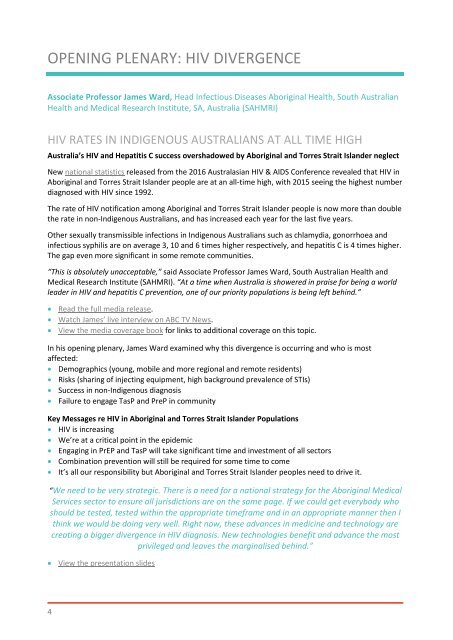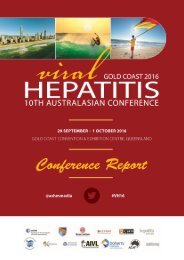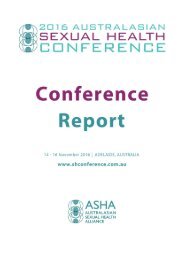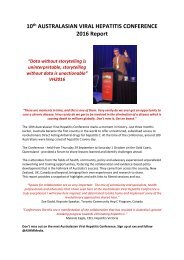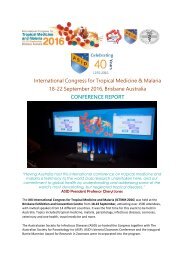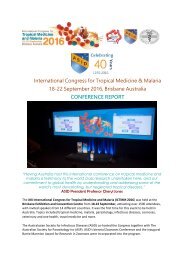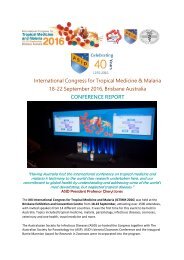AUSTRALASIAN HIV CONF REPORT 2016_FINAL
The Australasian HIV & AIDS Conference, run by ASHM, presents new and innovative research from across the Australasian HIV sector. Delegates include researchers, clinicians, policy makers, community organisations and activists. This 2016 Conference Report provides a collection of key learnings, with links to abstracts and presentations.
The Australasian HIV & AIDS Conference, run by ASHM, presents new and innovative research from across the Australasian HIV sector. Delegates include researchers, clinicians, policy makers, community organisations and activists. This 2016 Conference Report provides a collection of key learnings, with links to abstracts and presentations.
Create successful ePaper yourself
Turn your PDF publications into a flip-book with our unique Google optimized e-Paper software.
OPENING PLENARY: <strong>HIV</strong> DIVERGENCE<br />
Associate Professor James Ward, Head Infectious Diseases Aboriginal Health, South Australian<br />
Health and Medical Research Institute, SA, Australia (SAHMRI)<br />
<strong>HIV</strong> RATES IN INDIGENOUS AUSTRALIANS AT ALL TIME HIGH<br />
Australia’s <strong>HIV</strong> and Hepatitis C success overshadowed by Aboriginal and Torres Strait Islander neglect<br />
New national statistics released from the <strong>2016</strong> Australasian <strong>HIV</strong> & AIDS Conference revealed that <strong>HIV</strong> in<br />
Aboriginal and Torres Strait Islander people are at an all-time high, with 2015 seeing the highest number<br />
diagnosed with <strong>HIV</strong> since 1992.<br />
The rate of <strong>HIV</strong> notification among Aboriginal and Torres Strait Islander people is now more than double<br />
the rate in non-Indigenous Australians, and has increased each year for the last five years.<br />
Other sexually transmissible infections in Indigenous Australians such as chlamydia, gonorrhoea and<br />
infectious syphilis are on average 3, 10 and 6 times higher respectively, and hepatitis C is 4 times higher.<br />
The gap even more significant in some remote communities.<br />
“This is absolutely unacceptable,” said Associate Professor James Ward, South Australian Health and<br />
Medical Research Institute (SAHMRI). “At a time when Australia is showered in praise for being a world<br />
leader in <strong>HIV</strong> and hepatitis C prevention, one of our priority populations is being left behind.”<br />
Read the full media release.<br />
Watch James’ live interview on ABC TV News.<br />
View the media coverage book for links to additional coverage on this topic.<br />
In his opening plenary, James Ward examined why this divergence is occurring and who is most<br />
affected:<br />
Demographics (young, mobile and more regional and remote residents)<br />
Risks (sharing of injecting equipment, high background prevalence of STIs)<br />
Success in non-Indigenous diagnosis<br />
Failure to engage TasP and PreP in community<br />
Key Messages re <strong>HIV</strong> in Aboriginal and Torres Strait Islander Populations<br />
<strong>HIV</strong> is increasing<br />
We’re at a critical point in the epidemic<br />
Engaging in PrEP and TasP will take significant time and investment of all sectors<br />
Combination prevention will still be required for some time to come<br />
It’s all our responsibility but Aboriginal and Torres Strait Islander peoples need to drive it.<br />
“We need to be very strategic. There is a need for a national strategy for the Aboriginal Medical<br />
Services sector to ensure all jurisdictions are on the same page. If we could get everybody who<br />
should be tested, tested within the appropriate timeframe and in an appropriate manner then I<br />
think we would be doing very well. Right now, these advances in medicine and technology are<br />
creating a bigger divergence in <strong>HIV</strong> diagnosis. New technologies benefit and advance the most<br />
privileged and leaves the marginalised behind.”<br />
View the presentation slides<br />
4


